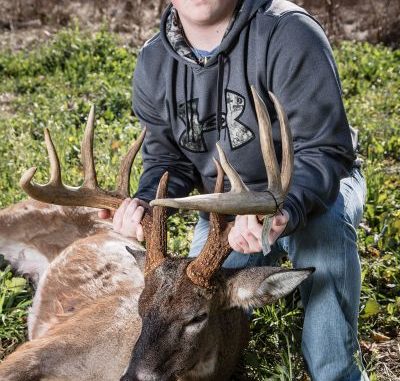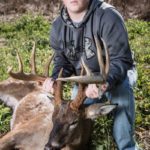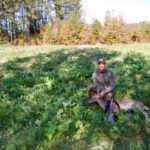
Most hunters just can’t wait to get food plots planted. But should we wait until later in the season? Here are some thoughts about why that might produce more deer action.
When former Louisiana Sportsman editor Todd Masson and I first started managing my property in Washington Parish for better deer hunting, our number one objective was to put in food plots.
These small plots became the driving force behind the Postage Stamp Plots series that ran between 2009 and 2012.
As noted in the 2011 installment, Masson and I became more addicted to food plots for feeding deer than we were killing deer.
However, something strange has happened since that series of articles came to an end: I’ve been just as eager since then to plant food plots for deer, but I’ve discovered the deer just don’t seem to be as eager to eat in my plots anymore.
An accidental discovery last year has me ready to get back on the tractor this year. But if what I saw last year was any indication, don’t expect me to get on it until late October or early November.
Let me explain why.
Last year I brought back Brandon Voth with Keith Voth Dozer & Excavation (985-515-7253) to open up a three-acre hole in the woods on the other side of a slough behind my house.
Since I didn’t lime the plot, I planted Wrens Abruzzi rye, wheat and crimson clover because of their tolerance for acidic soil.
I hung a two-man ladder stand on the south side of the opening and dreamed of winter evenings watching, with my son at my side, deer browse through what we eventually dubbed the 700 Club.
Considering it was a brand-new plot, my expectations weren’t the highest, but with the lush buffet of green I was offering them I figured they would eventually find it and feast.
A brief inspection the week before the early youth season turned up scant browsing in one corner of the plot. The rest of the plot was just about knee high and already turning stemmy and unpalatable.
Rather than watching deer, my son and I watched the plot grow taller and taller with each successive hunt.
By the end of November, I was thoroughly disgusted and scouted out other places to hunt.
While passing through one of the spots that Masson and I had first planted back in 2008, I halfheartedly tossed out some leftover Abruzzi rye seed on a newly bulldozed road. The plot had lain fallow for a couple years, and I was wondering if I could drum up a little attention.
As my three-acre plot continued to grow on into December, the little patch I planted by the cemetery plot sprouted lush and green.
And much to my surprise, it looked like somebody took a finishing mower to it for the remainder of the deer season.
It never got more than 3 or 4 inches high.
So I vowed that I would not plant this year until the last week of October — at the earliest — and more likely the first week of November.
Waiting such a long time might not seem like a wise decision, but like I always tell my son when he’s at baseball practice — if what you’re doing isn’t working, make an adjustment.
Timing the planting of food plots really has more to do with soil temperature and the average date of the first frost than it does anything else.
But it seems to me, this general rule is more geared for northern states than the Deep South.
Take somebody like Chad Wall, for example. The host of Wallhanger TV lives in Springfield, but he plants food plots in the Midwest, where he puts in a lot of stand time come winter.
When he started traveling to hunt, Wall realized the importance of having plots for deer to eat all year long. Since he’s trying to grow a decent, healthy herd, he’s gotten into running plots 12 months out of the year by replanting twice a year — once for spring/summer and again for fall/winter.
But down here, aside from our local deer seemingly mowing down a plot of iron clay peas or soybeans overnight, anything I seem to plant while it’s still warm with the intent of hunting over during fall and winter doesn’t seem to be nearly as attractive as natural browse or acorns scattered on the ground.
If your plots are anything like mine, you’ve probably noticed that when you planted in late September or early October, deer have a tendency to eat in one particular spot. And they’ll eat on that one spot all winter long, with hardly a nibble outside that spot.
“I’ve found deer will come in on a new plot and start eating on it in one or two of the corners as soon as it comes up,” Simsboro’s Sid Havard said. “And if your deer populating isn’t all that large, they’ll just keep hitting that spot over and over again as the rest of the plot takes off because of our Louisiana weather.”
Havard theorized deer keep hitting the same spots while the rest grows woody and unpalatable because those are the only spots in the plot that continue to produce tender, new growth.
“When they browse on the plot, it’s naturally going to want to put on new growth,” he explained. “And it’s that new growth that keeps them coming back to that same spot, while they leave the rest alone.”
Well, if one little spot of tender, new growth is so attractive, imagine what deer think of an entire plot of tender, new growth.
I started thinking hard about planting later in the year after talking with Karl Casanova, a neighbor with whom I go to church. Many of our after-church discussions eventually turn to deer hunting.
As one who used to plant early, Casanova told me not too long ago that he had been pushing back his food-plot planting until the third week of October.
“I don’t know for sure,” he said, “but it seems the later I plant it the better they eat it. I don’t think any of it is very scientific, but it seems like the vegetation doesn’t grow nearly as fast the later you plant it, either.”
And that one little comment made a lot of sense to me: Plants that grow like gangbusters during summer-like weather eventually start to slow down.
The problem with my having planted too early in the past was that the plants in my food plot were already too tall when they started slowing down.
Now, I suppose if I had a deer population that rivaled Giles Island, I could get away with planting in late September or early October. However, fewer deer combined with more-than-enough food keeps deer from feeding too much in wide-open food plots.
The key seems to be timing your food plot planting so your vegetation is at just the right size at just the right time.
For most of us, that means timing our food plots so they are most attractive to does right before the rut.
Although the timing doesn’t have to be perfect, it needs to be pretty darn close.
When I look at the Louisiana Sportsman rut calendar, I see that Washington Parish is in Area 4, which has some of the latest rutting deer in all of Louisiana. And based on firsthand observation from the stand, I need to time my food plots so they are at peak attractiveness around the second or third week of December.
With a bag full of fall annual seeds like oats, wheat, Abruzzi rye or brassica and a few sacks of Triple 13, I’m confident I can plant right in front of a good rain during the last week of October or the first week of November and have a plot deer can’t help but destroy.
Since my objective has switched from planting food plots to actually putting deer in the freezer, it’s high time I make an adjustment.




